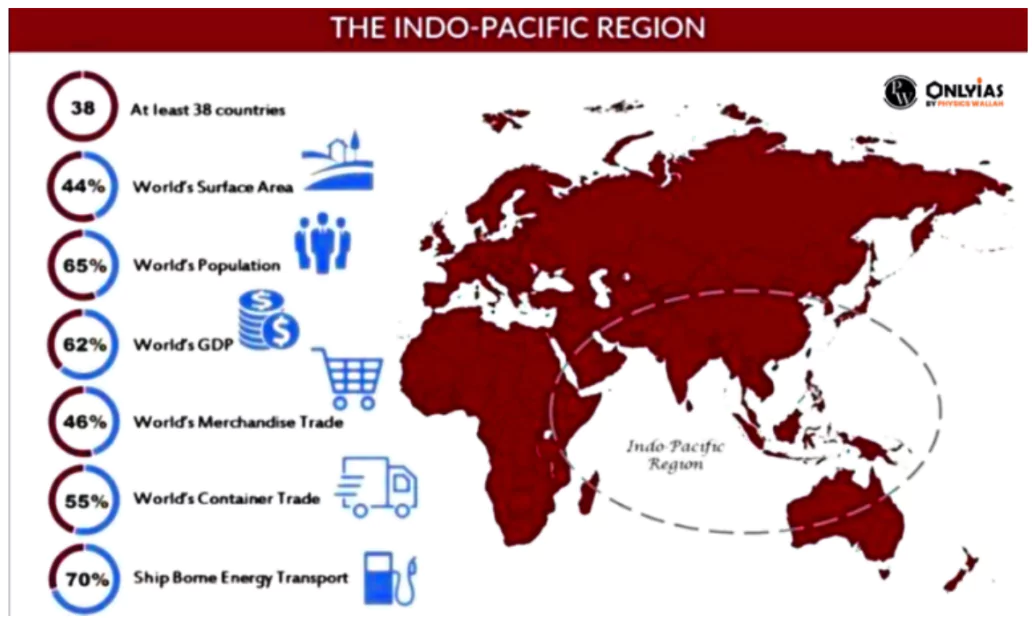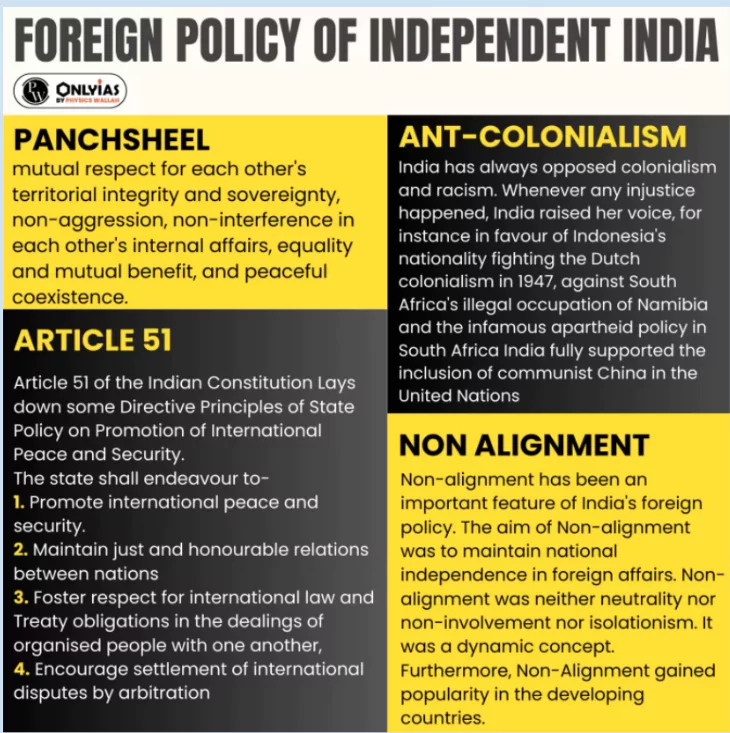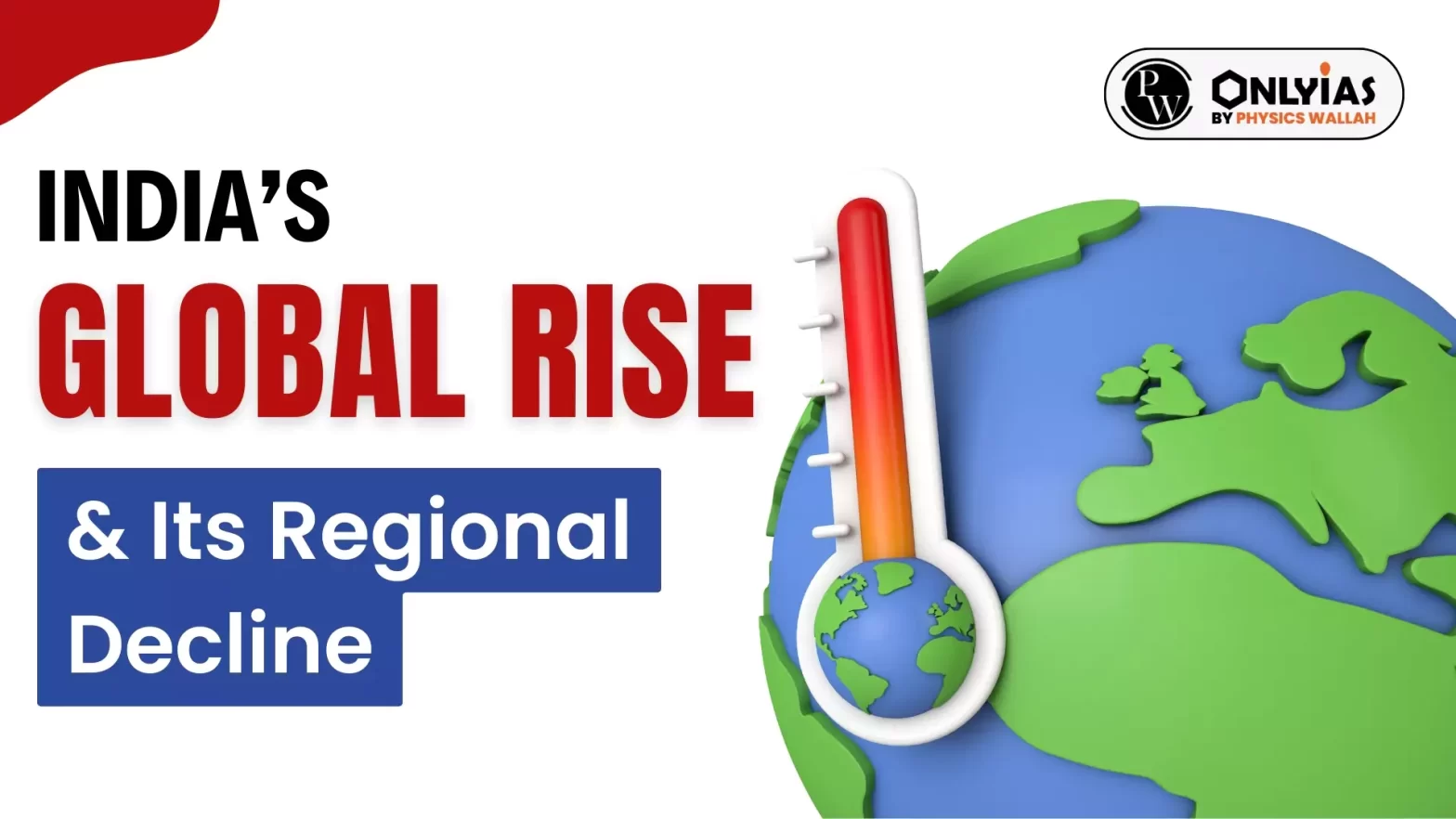Context
A paradox is emerging in contemporary Indian Foreign Policy. While India’s global power is rising, its influence in the South Asian region is declining.
Factors Behind India’s Global Rise
Factors of India’s Global Rise: India’s global rise stems from the growth in absolute power and the geopolitical choices made by the leading powers of the contemporary international system.
- Growth in Absolute Power: India’s aggregate power has grown over the past two decades — evident in robust economic growth, military capabilities, technological advancement and a largely young demography.
- Economic Growth: India’s economy has surged from 10th to the 5th largest global economy. This trajectory is underpinned by a robust growth rate, projected at 7% for FY24, and likely continuing into FY25.
- As per the World Bank, India’s output growth would be 7.5% in FY24.
- As per Global rating agency Moody’s, India’s GDP growth projection for FY24 is 6.8%.
- Enhancement in Military Capabilities: India is one of the few countries to have designed and produced a fourth-plus generation fighter aircraft, nuclear submarine, successful Surface-to-Air Missile (SAM) system, Main Battle Tank (MBT), an ICBM and an indigenised Ballistic Missile Defence System.
- India’s Defence Exports surged from surging from Rs. 686 Crore in FY 2013-14 to nearly Rs. 16,000 Crore in FY 2022-23. It has grown 800% in five years and reached 85 countries across continents.
- Technological Advancement: India’s technological advancement in 2023 showcased a commitment to innovation and self-reliance.
- From semiconductor manufacturing to space exploration, defence capabilities, and rapid advancements in telecommunications, India is actively shaping the global technology landscape.
- Examples: Launch of 104 Satellites in a single flight by PSLV-C37 in 2017, launch of Aditya-L1 Mission in 2023 (the first space-based Indian mission to study the Sun), commissioning of the indigenous aircraft carrier (Indian Naval Ship Vikrant, the first in 2022), etc.
- Focus on Contemporary Issues: India’s leadership and role in the International Solar Alliance and Global Biofuel Alliance demonstrates its commitment to promoting renewable energy.
- Young Demography: India, with its large and young population, is currently experiencing a demographic dividend. It is expected to last until 2055, providing India with a unique opportunity to boost its economic growth.
- As per the IMF, the demographic dividend could add about 2% points per annum to India’s per capita GDP growth over the next two decades.
- Geopolitical & Peer Accommodation: India’s inclusion in key global institutions such as the G-20, as an invitee at G-7 meetings, and active participation in multilateral groups such as the Quad, BRICS, and the Shanghai Cooperation Organisation further highlight its geopolitical significance and its powerful presence globally, even if it is not being a permanent member of the United Nations Security Council.
- A Conducive ‘Chaotic’ International Situation:
- Indo-Pacific Focus: India’s global rise is also aided by growing international attention on the Indo-Pacific, a region that is pivotal to global strategic stability, where India has a central position.
- Non-Aligned Diplomacy: India follows a strategy of non-alignment and reformed multilateralism that helps India to build trust and maintain its relations with all countries.
- Examples: India’s recent decision to abstain from voting against Russia in the United Nations General Assembly and purchasing of Russian crude oil despite western sanctions on Russia (during Ukraine-Russia conflict) and providing humanitarian support to Palestine while maintaining diplomatic ties with Israel.
- Soft Power: India is globally recognized as a non-aggressor country, whose vision is inclusive and worldview rests in the idea of “Vasudhaiva Kutumbakam – the world is one family.”
- Diaspora: 31 million people living in 200 countries. They act as a bridge between India and other countries.
- As per Global Soft Power Index, India has jumped a spot from rank 29 in 2022 to 28 in 2023.
Enroll now for UPSC Online Course
Indo Pacific Region

The term “Indo Pacific region” gained prominence recently and refers to a geopolitical concept that surrounds a vast maritime area in the Indian Ocean and Pacific Ocean.
- It spans from the eastern coast of Africa to the western coast of the Americas and is strategically significant due to its major trade route, important sea lanes, and critical maritime chokepoints it contains.
India’s Initiatives to Shape the Indo Pacific Region:
- India stands for a free, open and rules-based Indo-Pacific region. For India, the Indo-Pacific is an inclusive space for all stakeholders based on common responsibilities and common interests.
- India’s vision towards the region is based on the trinity: open, integrated and balanced region.
- Act East: Moving from Look East Policy to Act East policy.
- SAGAR: Strategic vision for the Indian Ocean, “Security and Growth for All in the Region” (SAGAR).
- Indo-Pacific Oceans Initiative: It is an initiative that builds upon the SAGAR initiative. It endorses an open, inclusive, non-treaty-based global initiative for mitigating challenges especially in the maritime domain through practical cooperation.
|
Decline in India’s Regional Power
India’s regional decline is a product of the dynamics of comparative power, and geopolitical choices made by the region’s smaller powers.
- Dynamics of Power: When compared to India’s influence in the region during the Cold War or in comparison to China’s influence in the region today, India’s power and influence in the region has sharply declined.
- Rising Chinese Influence: India is facing stiff geopolitical competition for influence in South Asia. China’s rise will mean that India may no longer be the most consequential power in the region.
- In Maldives, China’s rising influence has raised concerns about India-Maldives Relations. Also, recently Maldives has seen a campaign called “India Out”, labeling Indian presence as a threat to sovereignty.
- In Nepal, Gorkhas are increasingly deviated to China from India forces due to the new Agniveer Scheme.
- In Sri Lanka, there is also growing China’s influence (especially through Hambantota Port).
- China’s String of Pearls Strategy and China-Pakistan Economic Corridor are another concerning projects for India.
- Geopolitical Choices Made by the Region’s Smaller Powers: South Asia’s smaller powers, India’s neighbours, are engaged in a range of strategies- balancing, bargaining, hedging and bandwagoning. India’s smaller neighbours seem to find China as a useful hedge against India, for the moment at least.
- Some smaller nations such as Nepal, Bhutan, Maldives in South Asia perceive India’s actions as an attempt to assert its hegemony that has led to a sense of mistrust with India and engagement with China.
- India’s Indo-Pacific Focus: In the Indo-Pacific, while attention has grown, India’s global importance as a vital player might have strained its capacity to engage with its continental neighbours, given its focus on the great power dynamics in the region.
- Obsolescence of South Asia as a Geopolitical Construct: The traditional concept of South Asia as a geopolitical entity is becoming obsolete and has further marginalized India’s role in the region, diminishing its hold and influence.
- Strained Relations with Neighbours:
- Border-disputes: India has long-standing border disputes, particularly with China (Line of Actual Control) and Pakistan (Line of Control) that has led to military conflicts and tensions.
- India-Sri Lanka faces tensions regarding ownership of Katchatheevu Island.
- India-Nepal also faces boundary disputes, especially regarding the Kalapani-Limpiyadhura-Lipulekh trijunction area in western Nepal and the Susta area in southern Nepal.
- Cross-border Terrorism: India has been a victim of terrorism perpetrated by groups based in neighbouring states, especially Pakistan.
- Water-dispute: Water sharing has been a source of tension over the allocation and use of water resources, which has led to disputes, such as disputes over the Indus water treaty with Pakistan.
- India and Bangladesh have signed only 2 treaties out of 54 common rivers they share, including the Ganga Waters Treaty and The Kushiyara River Treaty.
- India and Nepal have traditionally disagreed over the Sugauli Treaty signed in 1816 between the British East India Company and Nepal, which delimited the boundary along the Maha Kali River in Nepal.
- Political Instability: Some of India’s neighbours have experienced political instability and internal conflicts that have had an impact on regional stability and security, such as the military coup in Myanmar in 2021.
Enroll now for UPSC Online Classes
India’s Global Paradox: Regional Decline, Global Rise
Factors that have led to the decline of Indian influence in the region are also the reasons behind India’s global prominence;
- American Withdrawal: The withdrawal of America from the South Asian region and China filling that power vacuum have been disadvantageous to India.
- But, at the same time, a major reason why the US and its allies are keen to accommodate India’s global interests.
- The Indo-Pacific Region: While interest in the Indo-Pacific has increased, India’s global prominence as an indispensable Indo-Pacific power, India’s focus on the great power balance in the Indo-Pacific may have impacted India’s relations with the neighbourhood.
- To that extent, overlooking the balancing acts by the region’s smaller powers to focus on the great power balancing might become counterproductive.

Implications of this paradox for India:
- Implications on Global Aspirations: The dichotomy between India’s global rise and regional decline has profound implications for India’s global aspirations.
- Question on Credibility: It raises a legitimate question whether a country that is unable to maintain primacy in its periphery will be able to be a pivotal power in international politics.
South Asian Region:
- Comprises: It is the southern region of Asia that consists of Afghanistan, Bangladesh, Bhutan, India, Maldives, Nepal, Pakistan, and Sri Lanka.
- Demography: South Asia’s people are its biggest asset but remain wastefully underutilized.
- Half its population is under the age of 24 and over one million young people are set to enter the labor force every month until 2030.
- If the quantity and quality of South Asia’s human capital were to improve, regional GDP per worker could double.
India’s Principles on Foreign Policies:
- Panchsheel: These principles first mentioned in the 1954 Sino-Indian Agreement. It is based on following five principles:
- Mutual respect for each other’s territorial integrity and sovereignty
- Mutual non-aggression
- Mutual non-interference
- Equality and mutual benefit
- Peaceful co-existence
- India First Policy: India prioritizes its national interests in its foreign policy decisions, asserting its independence and confidence on the global stage.
- Strategic Autonomy: Independence of decision making and strategic autonomy are yet another significant features of India’s foreign policy. India thus believes in Partnerships and shuns Alliances, particularly military alliances.
- Vasudhaiva Kutumbakam Principle: India believes and follows the concept of “Vasudhaiva Kutumbakam- The World is One Family,” promoting global harmony and growth through the principles of “Sabka Saath, Sabka Vikas, Sabka Vishwas.”
|
Way Forward
- Counter China Challenge: India must revisit some of its traditional conceptions of the region, ‘modernise’ its primacy in South Asia, and take proactive and imaginative policy steps to meet the China challenge in the region.
- Capitalizing on India’s Strengths in Regional Engagement: India should prioritize leveraging its strengths instead of attempting to compete directly with the People’s Republic of China in every aspect, which is an impractical pursuit.
- It’s crucial to devise a fresh approach to regional involvement that aligns with India’s traditional advantages and the evolving realities of the region.
- Reasserting its Buddhist heritage serves as an illustrative strategy.
- Leveraging India’s Maritime Advantage: India’s continental strategy presents numerous obstacles, whereas its maritime domain offers ample opportunities to boost trade, participate in mini-laterals, and forge issue-based coalitions, among other endeavors.
- Engaging South Asian Neighbors in Indo-Pacific Strategy: This might entail integrating India’s smaller South Asian neighbors into Indo-Pacific strategic dialogues. While many of them are maritime nations, they currently have limited involvement in the Indo-Pacific initiative.
- Expanding Indo-Pacific Partnerships: India and its allies (the U.S., Japan, Australia, the European Union, and others) should explore avenues to engage and collaborate with Sri Lanka, the Maldives, and Bangladesh within their broader Indo-Pacific strategy.
- Tap Soft Power: India should harness its soft power to maintain influence, fostering informal contacts and conflict management processes in the region.
- Diversify Engagement: India needs to focus on collaborative development projects that address contemporary and specific needs, such as joint research in areas like agriculture, renewable energy, climate issues, disaster management, cybersecurity, Artificial Intelligence, etc.
- Enhance Regional Cooperation: India should prioritize enhancing cooperation and collaboration within South Asia by revitalizing initiatives like SAARC (South Asian Association for Regional Cooperation), BIMSTEC (Bay of Bengal Initiative for Multi-Sectoral Technical Cooperation) and promoting bilateral partnerships with individual South Asian countries.
- Maintain & Focus on its Own Ideology: India needs to re-focus on its Neighbourhood First policy and prioritize inclusive development projects and needs to foster mutual trust.
- South Asia at Heart of Global South: India needs to enhance its regional diplomatic ties by focusing the South Asian region as a pivotal player in the Voice of Global South Summits.
- India should try to incorporate ethical principles into its foreign policy, reclaiming moral leadership globally, as advocated by Mahatma Gandhi in his words as politics without principles and ethics would be disastrous.
Enroll now for UPSC Online Course
Also Read: India’s Neighbourhood First Policy
![]() 7 May 2024
7 May 2024

